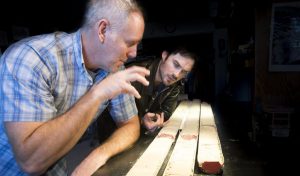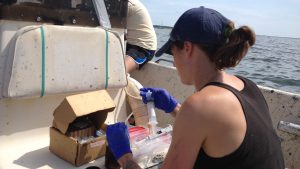Search results for: ❤️ Dating voor mij: www.Dating4Me.site ❤️ Betekenis Dating Naach Phat
Estimating Denitrification in North Atlantic Continental Shelf Sediments
Estimating Denitrification in North Atlantic Continental Shelf Sediments Seitzinger, S.P. and A.E. Giblin Biogeochemistry, Vol. 35, pp. 235-260, 1996 WHOI-R-96-011
Read MoreSediment Cores Hold Clues to Past Climate
June 1 marked the start of the Atlantic hurricane season. After last year’s extremely active and costly hurricane season, many are asking whether ocean warming, sea-level rise, and climate disruption are signaling a new, more intense hurricane regime. Should we in the Northeast do more to prepare for powerful hurricanes? To know what to expect,…
Read More2002-2004 Projects
Developmental Effects of Contaminants on Salinity Preference and Seawater Survival for Atlantic Salmon: Integrating Physiology and Behavior Stephen D. McCormick, Darren T. Lerner, and Emily Monosson, University of Massachusetts, Amherst Over the last 20 years populations of Atlantic salmon (Salmo salar) in northern New England have decreased ten-fold, resulting in their recent listing as an…
Read MoreShellfish
Shellfish Research » Identification of the cause of hemic neoplasia in Mercenaria mercenaria and development of management methods NRAC-USDA Fall 2017 – Fall 2019 » Market Development to Diversify Shellfish Aquaculture Products in Massachusetts NOAA SG Aquaculture Initiative: Addressing Impediments to Aqua. Opportunities Sept. 2017 – Sept. 2019 » Piloting surf clam aquaculture techniques to…
Read MoreAquaculturists
Aquaculturists Our region is home more than 300 shellfish farming operations on over 1,000 acres. Woods Hole Sea Grant extension agents meet regularly with aquaculturists and provide them with technical assistance based on research and our knowledge of local habitats and conditions. WHSG also offers professional development opportunities to help shellfish farmers improve their operations.…
Read MoreUnderstanding the Waquoit Bay Ecosystem
A Q&A with Sarah Foster Sarah Foster is a Boston University graduate student doing her dissertation research in Waquoit Bay (Cape Cod, Massachusetts). A biogeochemist, Sarah investigates the impact hypoxia, or low oxygen, in the water has on crucial functions within Waquoit Bay’s ecosystem. She recently published research she and her co-author, Wally Fulweiler conducted in…
Read MoreTechnology Enables Better HAB Monitoring and Mapping
Technology Enables Better HAB Monitoring and Mapping The project’s sampling plan for the Nauset area of Cape Cod. Sept. 2018 — Nauset Marsh in Eastham, Mass. on Cape Cod serves as a “natural laboratory” for researchers working to better understand harmful algal blooms (HABs) or red tide. HABs in Nauset are caused by the phytoplankton…
Read MoreHydrodynamical Modeling of a Multiple-inlet Estuary/Barrier System: Insight into Tidal Inlet Formation and Stability
Hydrodynamical Modeling of a Multiple-inlet Estuary/Barrier System: Insight into Tidal Inlet Formation and Stability Friedrichs, C.T., D.G. Aubrey, G.S. Giese, and P.E. Speer In: Aubrey, D.G. and G.S. Giese (eds.), Formation and Evolution of Multiple Tidal Inlets, Coastal and Estuarine Studies, American Geophysical Union, Washington, D.C., Vol. 44, pp. 95-112, 1993 WHOI-R-93-010
Read MoreSediment Cores Hold Clues to Past Hurricanes
Sediment Cores Hold Clues to Past Climate June 1 marked the start of the Atlantic hurricane season. After last year’s extremely active and costly hurricane season, many are asking whether ocean warming, sea-level rise, and climate disruption are signaling a new, more intense hurricane regime. Should we in the Northeast do more to prepare…
Read MoreWHOI-R-98-003 Gonzalez-Gil, S. Detection and
WHOI-R-98-003 Gonzalez-Gil, S. Detection and
Read More

